#lyrics are from gypsy queen by akina nakamori
Explore tagged Tumblr posts
Text



"The two of us ended up on page one hundred and twenty-five"
#I've been lately humming it these days#lyrics are from gypsy queen by akina nakamori#dwd91#drakepad#drake mallard#launchpad mcquack#darkwing duck 91#darkwing duck#my art stuff#Spotify
111 notes
·
View notes
Text
The many curses, ghost stories and urban legends of Yukiko Okada
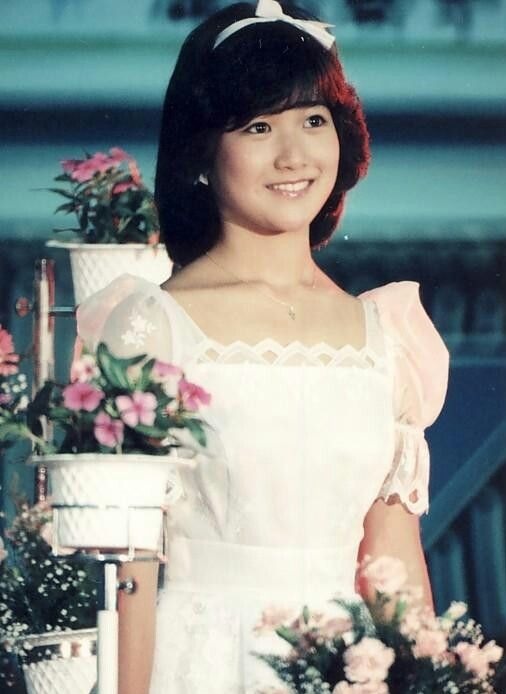
On april 8, 1986, 18 year old idol Yukiko Okada shocked the nation when she commited suicide at the height of her fame and popularity by jumping off the Sun Music building in Tokyo, Japan. The reason or reasons for her suicide are unclear, ranging from loneliness, stress, immense pressure and overwork, mental and physical health problems, a forbidden love affair and an illict pregnancy, with the most accepted theory being her unrequited love for actor Tōru Minegishi, who had rejected her. Notes were also discovered later which ended with “I wanted to see him again” and “My heart has nowhere else to go”
Whatever the case, Yukiko’s suicide caused an uproar in japanese society. Graphic scoop photographs were quickly taken of her dead body, brains strewn across the concrete, and printed in newspapers and magazines. A string of copy-cat suicides by jumping off of buildings were reported to such an extent that the term “Yukiko syndrome” or “Yukko-syndrome” was coined for the phenomenon
Yukiko’s sudden and tragic death made a massive impression on the people of Japan, and soon rumors began to spread that Yukiko’s spirit was not quite at peace...
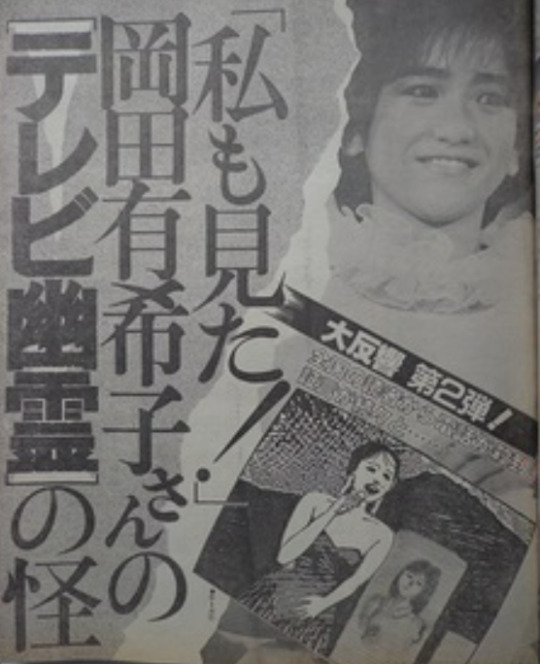
On June 18, 1986, the Fuji TV station was flooded with telephone calls from shocked viewers who claimed they had seen Yukiko’s ghost during Akina Nakamori’s performance of “Gypsy Queen” on Yoru no Hit Studio.
Sightings of her ghost included Yukiko in a yellow dress sitting and clapping amond the audience (actually guest Yoko Nagayama), Yukiko’s upper body emerging in one of the nearby light poles (actually just shadows and light reflections), her bloodied face showing up to the left of musician Demon Kogure (in actuality blurred red roses placed on the staircase). While others say her spirit could only be seen on the live broadcast and not in the recorded video
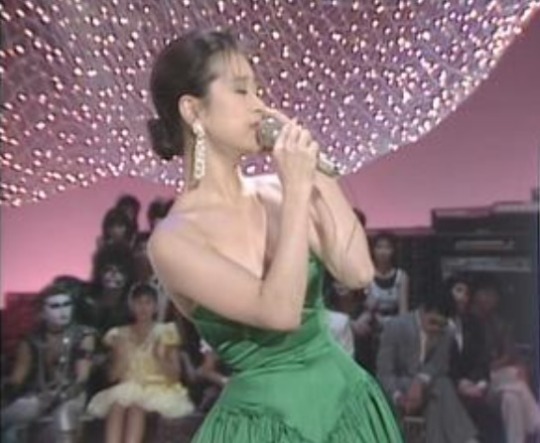
Rumors started to spread that Yukiko’s spirit had perhaps been summoned due to the song “Gypsy Queen”, a song it was said Yukiko was originally supposed to sing but was later handed over to Akina Nakamori, who was also said to have been a rival of hers in the industry. To add insult to injury, it was alleged the song was recorded on April 8, the day Yukiko died.
The lyrics of “Gypsy Queen” does bear some eerie parallels to Yukiko’s fate:
1. The two of us ended on page one hundred and twenty-five
Yukiko Okada jumped off at 12:05 on April 8
2. Halfway through our red-hot love
The cause of Yukiko Okada's suicide is said to be over her unhappy love for actor Toru Minegishi
3. Grieving to the heavy sky casting a wine red tint on everything
Yukiko Okada commited suicide by jumping down from the 7th floor of a building (flying into the sky) and dyed the ground with (wine red) blood
4. Sighs spill out onto my asphalt bed.
This one speaks for itself.
When Akina Nakamori three years later also attempted suicide, fortunately without success, rumors swirled that this was also the work of Yukiko Okada's angry spirit.
Although it is worth noting that Akina on the contrary were on friendly terms with Yukiko, and even burst into tears when she heard the news of of her death death. This didn’t put a stopper to the ghost stories though, this time it was speculated Yukiko’s spirit saved her life instead
Soon more legends about the restless spirit of Yukiko Okada appearing on programs such as "Pacific Saury no Manma" (where her ghost allegedly could be seen choking fellow idol and rival Seiko Matsuda) and "The Best Ten" quickly started to spread as well.
Another urban legend that quickly began to roam the nation, was that of the mysterious death of the man who photographed Yukiko’s dead body on the scene. It was said that the photographer even kicked her body unto her back for an even more graphic photo (this photograph is now said to be locked up along with other top secret documents in the Hochi Shimbum vault) Just one year later, the photographer died in a mysterious sauna or car accident, and people began to speak of the curse of Yukiko Okada.
This urban legend would eventually overlap with the now infamous “cursed Kleenex commercial”, which it was said this same man worked on, to the misfortune of it’s cast and crew who all allegedly went mad or died mysterious deaths (as well as anyone unfortunate or brave enough to watch it)
However, it did eventually turn out that the camera man who died in the accident and the man who photographed Yukiko’s body were two different people and the photographer is still alive and kicking to this day. That and the commercial was filmed in 1985, one year before Yukiko’s death.
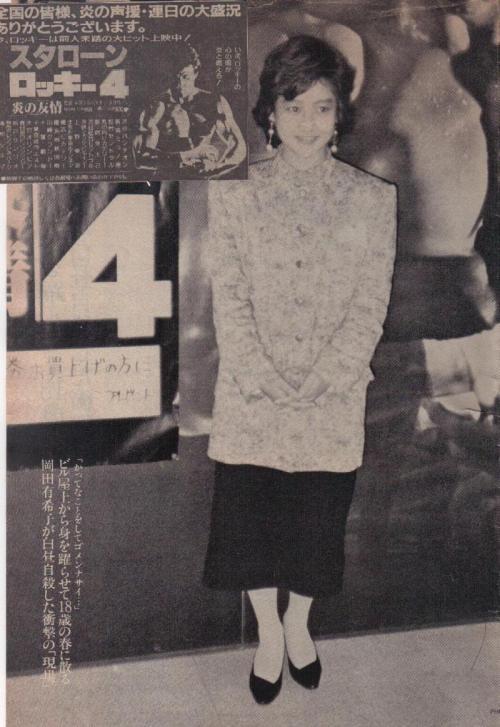
The number 4 is in Japan associated with bad luck and death. Yukiko Okada is famous for being intwined with this particular number. For example, her debut was in April, she committed suicide in April, she moved out of her production dormitory on April 4, and her new condominium room was Room 402. Most notably, a photo of Yukiko was taken of her at the premiere of Rocky 4. The truly ominous part is that is was taken the evening before her death.
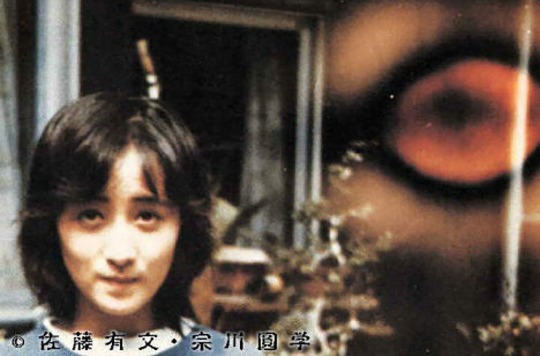
A spirit photograph, or psychic photograph, showing a young woman with what appears to be a giant, floating red eye to her right is said to depict Yukiko Okada the day before her death. What appears to be a giant red eye speculated to be the God of Death, ominously hoveri by her, waiting for the fatal hour it will take her soul to the spirit world. The photo turned out to actually be from a book collection of psychic photography from 1985, a whole year before Yukiko Okada killed herself.
Other sensational urban legends about Yukiko abound, like how singer and actress Erika Sawajiri is Yukiko Okada reincarnated as she was born April 8, the same day Yukiko committed suicide, as well as for her supposed love for older men, how Yukiko’s fans scooped up her brains and took them home and even ate them, how in Seiko Matsuda’s 1986 album "The Tears of the Puppet", you can hear the voice of Yukiko saying "thank you", perhaps Yukiko thanking Seiko for writing songs for her, how if you set a picture of Yukiko as your phone background you can hear her cry through the reciever, how according to a psychic a female ghost, speculated to be Yukiko, “very beautiful during her lifetime, and she was pregnant when she died, and she was very angry" haunts singer Minami Takahashi who was also born April 8, and how the japanese tv guide magazine “The Television” always poses their front page artists with a lemon as a protective charm against Yukiko’s ghost and curse.
To be honest, the whole concept of Yukiko Okada’s ghost / curse brings up mixed emotions in me. On one hand the idea of the restless, angry spirit of a beautiful girl who died tragically definitely captures one’s imagination, and it is an interesting reflection on society’s enduring fascination with celebrity, youth, tragedy, death and the paranormal, all in one package. On the other hand, the fact that the tragic death of this unhappy girl was turned into such sensational stories can be considered disrespectful, even expoitative in a way, to the memory of this talented, hardworking girl.
Akina Nakamori herself probably put it best with her response to the uproar; "Yukiko-chan is a lovely girl with a kind heart. I don't think she is like that."
Whatever your views are on the matter, what can not be denied is the massive impact Yukiko Okada’s tragic end had on Japanese society, an impact that can still be felt to this day, ghost or no ghost.

#yukiko okada#urban legends#urban legend#japanese urban legends#idol#idols#showa#showa era#80's japan#citypop#ghost stories#ghost#ghosts#akina nakamori#cursed kleenex commercial#j horror#jhorror#sort of
135 notes
·
View notes
Video
youtube
idk how many of you caught it in the lyrics, but “Shanikusai” does, unfortunately, include the word ‘gypsy’ as well as some stereotypes associated with it. (Nakamori Akina’s songs “LA BOHEME” and “Gypsy Queen” suffer from this also.)
in consideration of this, beginning in the late ‘90s “Shanikusai” was excluded from Momoe’s best albums and was even cut from the 1999 DVD release of her final concert. the song didn’t appear again until halfway through the 00′s, and even then seemingly only on ‘complete collection’-style best albums. Akina’s “Gypsy Queen” was treated similarly and has only shown up on best albums twice since 1992.
anyway, the point of this is to recognize that as much as I like “Shanikusai” and “Gypsy Queen” for Momoe and Akina’s respective performances, I won’t try to justify the songs themselves as products of their time… and neither has Japan apparently. let’s all just continue be mindful when appreciating songs from this era
7 notes
·
View notes